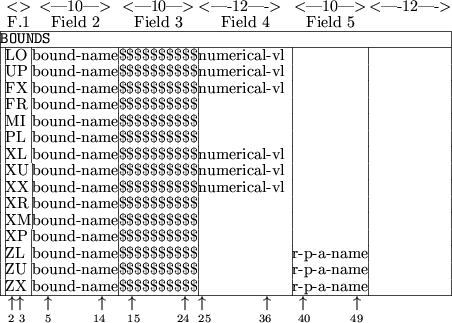 |
The BOUNDS indicator card is used to announce a vector of data giving lower and upper bounds on the unknown variables. The syntax for data following this indicator card is given in Figure 3.13.
The two-character string in data field 1 specifies the type of bound to be input. Possible values are: LO, XL or ZL, in the case of a lower bound, UP, XU, ZU,in the case of an upper bound, FX, XX, ZX,in the case of a fixed variable, i.e., the lower and upper bounds are equal, FR or XR if the variable is free, i.e., the lower and upper bounds are infinite, MI or XM, if there is no lower bound, and PL or XP, if there is no upper bound. The string bound-name in data field 2 gives the name of the bound vector under consideration. This name may be up to ten characters long. Several different bound vectors may be defined in the BOUNDS section.
The string $$$$$$$$$$ is used for two purposes.
If the card is of type LO, UP, FX, FR, MI, or PL, the string in data field 3 specifies to which variable the bound is applied. If the card is of type XL, ZL, XU, ZU, XX, ZX, XR, XM or XP, this string specifies an array of variables which are to be bounded. On such cards, the expanded array name of this string must be valid and the integer indices must have been defined in a parameter assignment (see Section 3.2.3).
For bounds of type LO, UP, FX, XL, XU or XX, the numerical value of the bound or array of bounds is given as the string numerical-vl, using at most 12 characters, in data field 4. For bounds of type ZL, ZU or ZX, the numerical value of the array of bounds is that previously associated with the real parameter array r-p-a-name specified in field 5. When both lower and upper bounds on a variable are required, they must be specified on separate cards. Possible combinations are LO-UP, LO-PL, MI-UP, XL-XU, XL-XP, XM-XU, ZL-XU, XL-ZU, ZL-ZU, ZL-XP and XM-ZU.
If default lower and upper bounds of zero and infinity, respectively, are in effect and a card with MI or XM in field 1 is encountered, the relevant lower bound is changed to minus infinity and the upper bound becomes zero. If the same defaults are in effect and an upper bound of zero is specified on a UP, XU or ZU card, the relevant lower bound becomes minus infinity. These two features are necessary for MPS compatibility.
